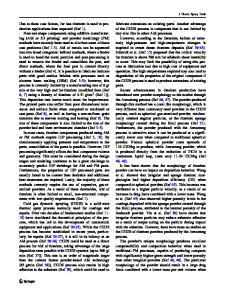In Situ Process Monitoring for Additive Manufacturing Through Acoustic Techniques
- PDF / 1,960,966 Bytes
- 14 Pages / 593.972 x 792 pts Page_size
- 72 Downloads / 450 Views
JMEPEG https://doi.org/10.1007/s11665-020-05125-w
In Situ Process Monitoring for Additive Manufacturing Through Acoustic Techniques Md Shahjahan Hossain
and Hossein Taheri
(Submitted March 21, 2020; in revised form July 17, 2020) Additive manufacturing (AM) is an emerging field where a complex geometrical model can be made with no requirement of individual parts and assembly production. This advantage provides the capability for fabricating components in a single integrated process. On the contrary, lack of non-destructive testing adoption due to complex geometries of final products, makes this technology less convenient for the production of critical parts with high accuracy. Non-destructive testing through acoustic techniques is one of the most popular methodologies for AM inspection because of its provision to detect defects on the internal structure of the components. The technique has also been used in other types of fabrication processes (machining and welding) for defect monitoring. There are several studies where acoustic data acquisition and analysis have been done to detect cracks and other anomalies. In this paper, the progress of using acoustic techniques for AM process and part quality monitoring has been reviewed, and critical discussion has been made for the potential application of acoustic techniques toward quality inspection and monitoring in AM technology. Keywords
acoustic emission (AE), additive manufacturing (AM), non-destructive testing (NDT), process monitoring
1. Introduction With the advancement in additive manufacturing (AM) technologies, the functional parts can be produced in addition to the conventional use of AM for prototyping. Complex geometries can be manufactured via AM technologies from computer-generated digital models. Using AM techniques, minimum or no material removal is needed, which is not currently possible through traditional manufacturing techniques (Ref 1). AM is spreading in many industries during the last few years, such as the medical equipment industry (Ref 2) and the aerospace industry (Ref 3). The key point in using AM for part production is that the parts made by AM methods must have at least similar mechanical characteristics compared to conventionally manufactured parts (Ref 4). Because of the complex geometries involved and complicated processing parameters, there is a high probability of manufacturing defects in AM due to changes in process parameters or quality of feedstocks. If these anomalies can be found during the manufacturing process, rather than after completion, manufacturing costs can be reduced. Currently, there is industrial demand to have a high-quality automated manufacturing product line. The need is to have real-time fault detection to ensure that higher-quality parts are being produced (Ref 5-8). Offline quality control, such as part sampling during production for inspection, can be expensive and time-consuming, sometimes resulting in rejection of the full lot (Ref 9). Md Shahjahan Hossain and Hossein Taheri, Department of Manufacturing Engi
Data Loading...











